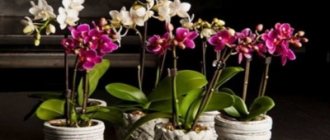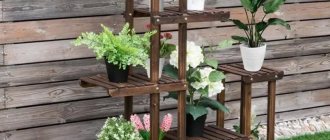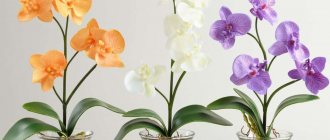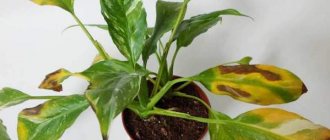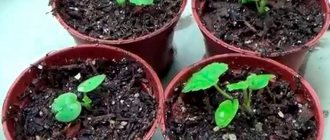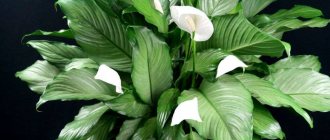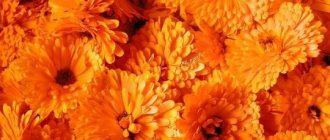Features of the flower “female happiness”
Usually spathiphyllums are hardy and unpretentious. But there are varieties that are capricious and sensitive to any errors in content. For example, a flower cannot tolerate stagnation of water and dies because of this.
It should be borne in mind that the root system of the plant develops to the sides, and not downwards, so the pots of an adult flower should be wide and shallow.
The root system does not tolerate overheating or hypothermia , so it is advisable to use vessels that do not allow these phenomena.
Which container is not suitable?
- A young spathiphyllum of a small plant cannot be planted immediately in a large container, since it will not be able to grow in it at all (how to plant spathiphyllum?).
- It is better not to use wooden or glass pots for growing this flower, otherwise there is a high probability of rotting of the root system.
- If you want to use a dark or transparent flowerpot, it is better to place it in a flowerpot to protect the roots from excessive heat.
- In no case should you choose a deep and narrow flowerpot, since the root system of spathiphyllum has a peculiarity: it develops in width and not in depth.
How to choose the right container for it in the store?
The plant requires oxygen to reach the roots, so in addition to light, breathable and loose soil, pots that do not retain moisture are needed.
A product made of any material will do . The only condition is the presence of drainage holes, which, when planting, should be covered with a convex piece of a broken pot and covered with expanded clay on top for drainage.
The most suitable option is a container made of baked clay without glaze.
Which pot is suitable for planting young plants?
Young spathiphyllums are planted in small pots. The roots must be cramped, otherwise the plant will become fat and will not bloom . The correct size is considered to be only 2 or 3 cm larger than the size of the spathiphyllum root system. Usually they take a pot for replanting that is slightly larger in size than the previous one. Replanting is necessary every year.
The pot for spathiphyllum can also be selected according to the height of the plants. For example, for a flower with a height of 5 to 10 cm, you can choose a product with a diameter of 9-10 cm.
A three-year-old Spathiphyllum usually requires a pot with a diameter of 19-20 cm.
Which one is better to choose if you need to transplant an adult specimen?
For adult plants, the size of the pot is selected according to the same rules as for young plants. The difference is that flowers are not replanted every year, but only when plant roots appear in the drainage holes or on the surface of the ground. In those years when flowers are not replanted, they simply need to change the top layer of soil.
What should you consider when choosing?
The variety that is presented to customers in stores is seriously confusing. Therefore, before purchasing a container for spathiphyllum, it is better to arm yourself with information, and only then go to the store.
Important! The choice of container size directly depends on the size of the plant.
Size
- A pot with a diameter of 9–10 cm is perfect for spathiphyllums with a height of 5–10 cm. This size will be ideal for the rapid development of the plant’s root system.
- For flowers that are 2–3 years old, you can purchase a container with a diameter of 18–20 cm. The main thing to remember is that the spathiphyllum rhizome grows to the sides, not down, so the pot should be wide and shallow.
Material
Suitable materials for growing spathiphyllum include plastic, wood, and in rare cases glass and ceramics, but gardeners prefer the latter due to a number of advantages:
- Pots made of porous ceramics allow the plant to breathe and remove excess moisture from the substrate through the walls of the pot.
- This material is environmentally friendly, and therefore absolutely harmless to spathiphyllums and any other plants as well.
- Ceramics are perfect for any type of interior because they look expensive and solid.
Important! Ceramic pots can be not only porous, but also coated with glaze, which prevents unnecessary moisture from leaking out from the soil in the container. Over the course of several years, the material accumulates salt deposits, which are almost impossible to get rid of, so the pot will have to be changed every 3 to 4 years.
The second most popular material is plastic. Its main advantage is its very low price, but, unfortunately, that’s where its advantages end. In such containers, plants will not be able to breathe, and they also often rot.
The difference between old and new containers
The new container for spathiphyllum should be slightly larger (in particular, 3 cm in diameter) than the previous one if it is being replanted regularly (once every 1 to 2 years), but a new pot may be required in other cases:
- When propagating a plant by dividing the rhizome, you need a pot that is 2–3 times smaller than the capacity of the plant divided into parts.
- Spathiphyllum, which has stopped its active growth, can increase the size of the pot by about two cm every 2–3 years, adding substrate if necessary.
Is it possible to plant flowers in transparent containers?
A transparent container for spathiphyllum can be made of glass or plastic. These materials cannot be called suitable for this plant, but its transparency will help novice gardeners avoid overwatering the substrate and thereby prevent rotting of the roots.
White deposits or traces of algae usually accumulate on the walls of the containers, which spoils the appearance of the plant, but this can be corrected by placing the pot in a flowerpot.
Spathiphyllum is an extremely unpretentious plant and can grow in a plastic or glass pot, but, nevertheless, in a ceramic container the growth rate will be faster.
Photos of suitable options
Further in the photo you can see which containers are suitable for propagation, proper care, watering, as well as replanting the “female happiness” flower at home.
Advice from the designer . Very interesting interior options are obtained if you choose the color of the pot for your green pet so that it echoes the surrounding colors in the setting.
How to properly transplant spathiphyllum
Transplanting female happiness at home is not difficult, if you do not rush and act carefully, novice flower growers can do it. First, you should remove the plant from the pot, assess the condition of the root system, and see if the bush needs to be replanted.
Before starting work, it is recommended to prepare:
- pot;
- drainage;
- soil;
- sharp knife;
- crushed activated carbon.
It doesn’t matter whether replanting or transshipment is done when moving the spathiphyllum to another pot, the base of the rosette, and even more so, the lower part of the petioles cannot be buried. This will lead to rotting of the bush; Spathiphyllum is unlikely to be saved.
Spathiphyllum transplant after purchase
As soon as women's happiness is brought into the house, it needs to be removed from the pot and the earthen lump inspected. The plant has practically no stem, the rhizome is short, if it rots or the soil has turned sour, very soon there will be nothing to save. At the slightest sign of trouble, regardless of the season, a transplant is done with cleaning of the sucking shoots, washing and disinfection of the roots, and complete replacement of the substrate.
If everything is in order, the spathiphyllum is quarantined for 2 weeks. Next, depending on the state of the earthen coma, they act according to one of the scenarios:
- The root is healthy, but there is practically no soil left in the pot. This means: the substrate is not visible behind the tangled shoots, and not that they simply entwined the soil. The blooming spathiphyllum is transferred, trying not to disturb the lump at all, into a pot 2-3 cm larger than before. If there are no buds, first shake off a little of the old substrate, straighten some of the side roots, and remove the drainage.
- Spathiphyllum is healthy, the ground is clearly visible. In spring and the first half of summer, transplantation or transshipment is done. At the end of the growing season or during the dormant period, leave the plant until spring.
- The root is rotting, the substrate is spoiled. An urgent (emergency) transplant is needed. Peduncles must be cut off.
Transfer
The most labor-intensive of operations, especially if it involves dividing the bush. Usually it is successful even for beginners, the main thing is not to be afraid and to have a steady hand.
Step by step:
- Take the flower out of the pot.
- Use a long stick with a blunt end to remove excess soil. You need to help with your hands very carefully so as not to damage the fragile processes.
- Inspect the root.
- If it rots or is too old, the spathiphyllum is disassembled into sockets.
- Clean the sucking shoots. Cut off softened, decaying, shriveled sections of the rhizome. Leaves that have hopelessly lost their decorative effect along with petioles and remnants of peduncles are removed.
- Soak in a fungicide solution, for example, foundation, for 20-30 minutes.
- Sprinkle the wound surfaces with crushed activated carbon.
- Dry to form callus. If the cuts were made only on overgrowing shoots, 30 minutes is enough. When a knife was used to strip rhizomes or separate rosettes, it will take 1-2 hours.
- Plant in pots with drainage and fresh soil.
- Gently crush the substrate. You can tap the bottom on the edge of the table.
Spathiphyllum must be watered abundantly after transplantation. Water should flow through the drainage holes.
If the plant has undergone division of the bush, replanting is possible in two options:
- Place the rosettes in separate small pots.
- The shoots are planted in one large container - this will immediately result in a lush, beautiful bush.
Transshipment
This transplant is the easiest to perform, gentle, and the flower resumes growth almost immediately. Used for healthy spathiphyllum, which does not need to be divided. Step by step:
- Remove the bush from the pot.
- Inspect the root.
- Remove old drainage.
- Free some of the lateral shoots from the soil. You need to act carefully, preferably with a stick with a blunt end. The lump cannot be destroyed.
- Take a pot 2-3 cm larger than before. Fill 1/3 or 1/4 with drainage and add 1 cm of fresh substrate.
- A plant is placed in the center.
- The free space is filled with soil.
- They are dying. Watered.
Transplanting a blooming spathiphyllum
It is better to perform the operation before the buds protrude. But the plant often produces them again in the fall or winter; choosing the right time is not always possible, given the crop’s need for annual replanting. It’s a pity to cut off flower stalks.
A healthy, well-groomed plant can be safely transferred to a larger pot during flowering. Wherein:
- they try not to disturb the earthen lump;
- the lateral roots do not straighten;
- further transplantation - as in the previous chapter, paragraphs 5-8.
Complete replanting with exposure of the roots, removal of the substrate, and stripping of the rhizome when spathiphyllum is flowering is not recommended. You need to choose from two options:
- wait until all the bedspreads grow old and turn green, cut them off;
- Before transplanting, remove young flower stalks and place in water.
Otherwise there will be problems. The plant simply cannot manage to bloom and restore damaged roots at the same time.
What to plant in for co-growing with anthurium?
Both plants have similar-shaped flowers, but the volume of the pot and the amount of soil for growth and flowering are different. Spathiphyllum blooms only after the roots are crowded, and anthurium roots need a lot of free space and a large pot.
There are two options for growing them together:
- Plant plants in different pots, but combine them in a common pot or beautiful basket.
- For planting, choose a special elongated pot with an internal partition, into two unequal parts. Plant spathiphyllum in the small part, and anthurium in the large part.
Which type of container is better?
The main difference between a pot and a flowerpot is the presence of an impenetrable bottom in the second. The container with the plant is inserted into a flowerpot, which can be placed anywhere: hung at a height or placed on a windowsill. It rather plays a decorative role, unlike a flowerpot, which has a specific function, but still it has its own advantages:
- A flower pot can hide any external imperfections in a flower pot. For example, ceramic flowerpots accumulate an unsightly white coating on the outside.
- As a rule, trays for draining water under the bottom of the pot have low sides, and if moved awkwardly, they can be dropped and liquid spilled. A flower pot can not only serve a decorative role, but also become a pallet that is more stable and safe.
- A flowerpot will help keep unstable flowerpots in balance.
- In the remaining space between the flowerpot and flowerpot, you can pour pebbles or expanded clay and fill it with water, which will help to perfectly humidify the air in the room.
- If during the period of use of the pot it loses its attractiveness, you will have to deal with the process of replanting the spathiphyllum, but the flowerpot can simply be replaced without touching the plant itself.
Each gardener chooses what he likes. Some people find it more convenient to use flower pots, while others prefer to use flower pots.
What available containers can you take to grow a flower?
In household supplies you can find ceramic pots for baking in the oven. By making holes in the bottom for drainage, you can get a good vessel for planting spathiphyllum.
Bowls, both large and small, are also suitable - they are not high, but wide enough. You can consider salad bowls of different sizes as pots for these plants . A prerequisite is the presence of drainage holes.
Spathiphyllums grow well with proper care. The above tips will help you understand the features of planting and growing plants.
Features of the plant
A distinctive feature of the exotic spathiphyllum is the absence of stems; the leaves grow almost close to the rhizome. They are distinguished by their oval shape and clearly visible relief veins.
Periodically, the plant produces white inflorescences on long stalks; they are very similar to the inflorescences of snow-white calla lilies. The flowering phase lasts almost 1 month, this happens twice a year. The main criterion for choosing a pot for spathiphyllum is its undemandingness to growing conditions and high decorative qualities.
To successfully grow a flower, it is recommended to prepare not only nutritious soil, but also a pot corresponding to the size of the root mass.
Spathiphyllum should be replanted 2-3 weeks after its acquisition. This time will be enough for the adaptation process to go smoothly. Such measures are due to the lack of useful components in the transport substrate in which the plant is offered for sale.
Basic rules for caring for spathiphyllum
It is not difficult to care for the flower; it is unpretentious. In order for the plant to actively develop, you should adhere to a number of recommendations:
- The flower loves bright color, but develops well in partial shade. The bush should not be kept in a dark room, as the leaves will become small.
- The “female happiness” flower is kept at an average room temperature of +22-23 degrees. Sometimes it grows well at +16 °C. A subsequent decrease in temperature leads to stunted growth and disease. The plant does not tolerate drafts.
- During growth and flowering, abundant watering is required. To do this, use settled warm water. In autumn and winter, water rarely and moderately. Excessive watering is harmful; if the soil is too wet, the roots will suffer.
- High air humidity is a prerequisite for good flower growth. When it’s warm outside, the bushes are sprayed 2 times a day. The flowerpot is placed in a container with wet pebbles.
- To transplant spathiphyllum into a new pot, select soil from humus, turf, leaf soil and peat. You can add sand and sphagnum. Turf soil should predominate.
- Fertilizing is applied 2 times a month throughout the entire period of flowering and growth, in winter - 1 time. Spathiphyllum loves organic fertilizers, especially bird droppings.
Transplantation is carried out using the transshipment method so as not to touch the roots. Adult bushes do not need to be replanted for up to 2 years.
Consequences of choosing the wrong container
If you choose a too small pot for spathiphyllum, soon after transplantation the root system will entwine the entire earthen ball. The flower will begin to experience an acute moisture deficiency, a lack of nutrients due to lack of soil.
A large flowerpot will negatively affect the flowering of spathiphyllum. Its root system will begin to actively grow, trying to absorb the entire volume of soil. This will take all the energy of the bush, and it will not bloom. Also, if you choose a large container, you can fill it with spathiphyllum, since the soil will not have time to dry out.
Having knowledge about the rules for choosing a pot and planting spathiphyllum, the gardener can confidently go to the store and buy the flowerpot he needs.
Is it possible to use flower pots?
A flowerpot is a decorative container in which an ordinary container with spathiphyllum growing in it is placed. The difference between an Ashpot and a simple pot is that there are no drainage holes in its bottom.
The flowerpot looks beautiful and can decorate any room. Its use provides a number of advantages:
- A pot made of ceramic may become covered with a white coating on the outside. A bright flowerpot will help hide the defect.
- Pallets on which pots stand can tip over, causing water to spill and ruin expensive furniture. A flowerpot will prevent such problems.
- Pots lose their aesthetic appearance over time. The planter will hide it.
- The flowerpot acts as an additional container for draining excess water.
- A decorative vessel is used to give stability to pots.
- Pots can be used to increase air humidity. To do this, expanded clay is placed in it, water is poured, and a pot with spathiphyllum is placed on top. As the liquid evaporates, it humidifies the air around the plant.
Replacing a pot is easier and faster than replanting spathiphyllum from an old pot to a new one, so it is advisable to use a decorative container.
